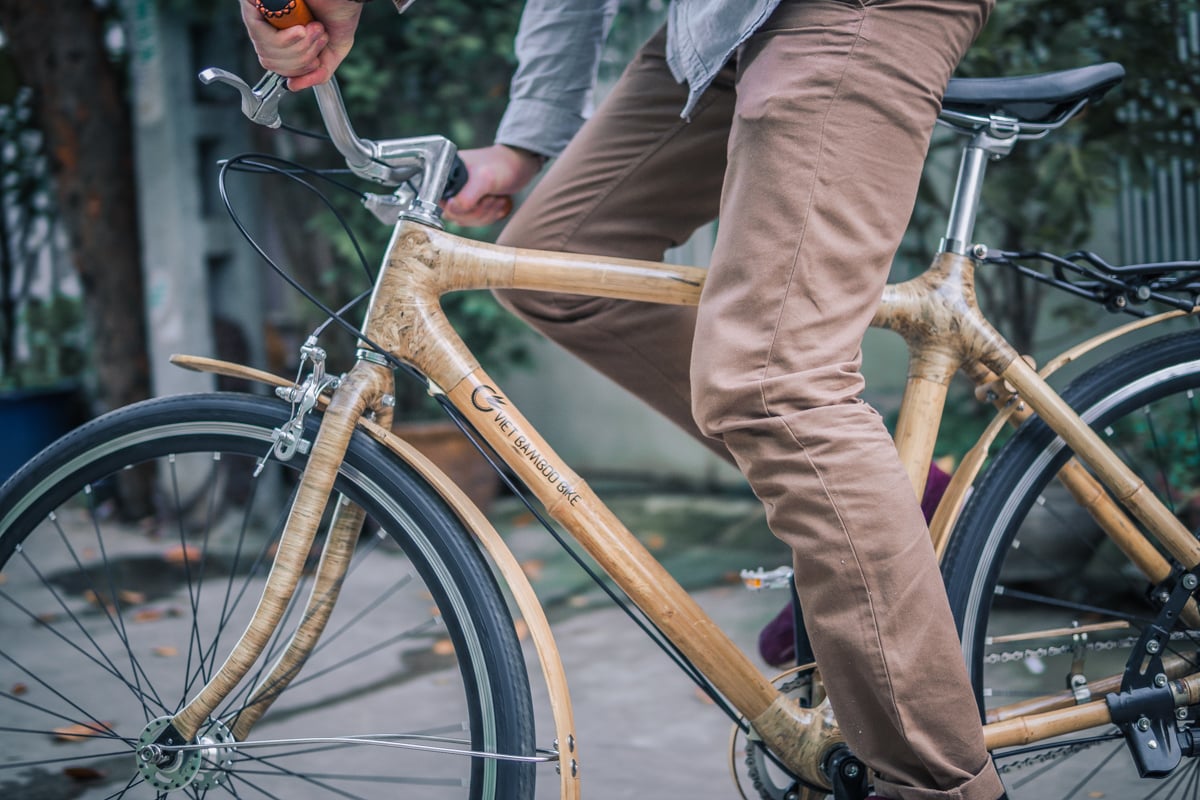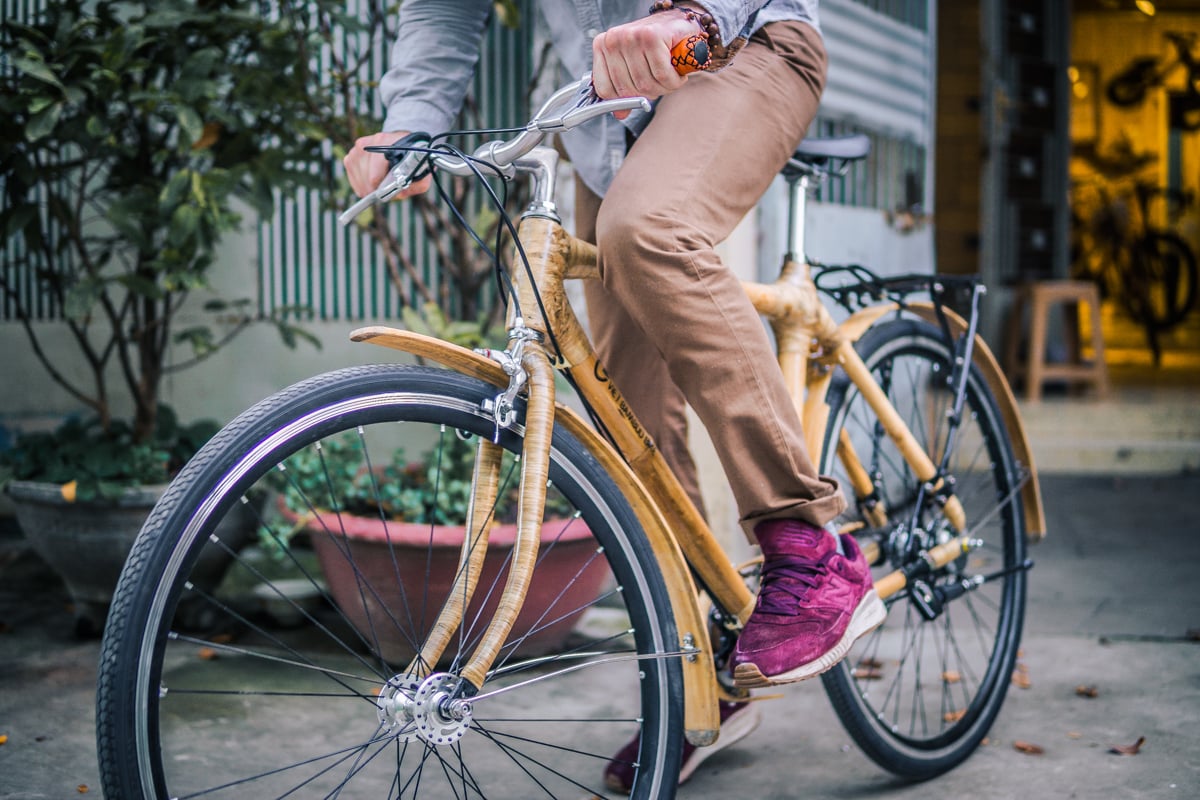The Vietcetera team recently had the chance to ride bamboo bikes in Ho Chi Minh City. We met with Tri Pham, founder of Viet Bamboo Bike, who conceptualized the bamboo bike product a couple of years ago while working in Germany for Mercedes-Benz. We tour his company’s showroom to understand his journey of designing and manufacturing his unique line of bamboo bikes in Vietnam.
How did the idea of making bamboo bike frames come to you?
It came to me five years ago when I was studying in Berlin. I attended a workshop to learn the basics of making a bike out of bamboo. At the end of my study, I was working in the automobile industry for Mercedes-Benz in Stuttgart. But I always had the idea of making my own bamboo bikes in the back of my mind.

At Mercedes-Benz, I learned how to use simulation and design programs. I utilized that knowledge to start designing a bamboo frame—to optimize the structure and its weight. In the meantime, I began doing research and found out that only a couple of people were making them. I tried to gather more information about it but access to this information was very limited.
Tell us about your journey from conceptualization to execution and operating a business in Vietnam?
I wanted to start my own venture so I quit my job in Germany and came back to Vietnam. In order to stay stable in the beginning I took a job as a project manager in the renewable wind energy sector.
Alongside this job, I spent my free time making bamboo frames. Finding the perfect design for the final frame has been a very long process. I went through countless prototypes, and finding trustworthy bamboo suppliers and related materials has been a challenge.
I still have my very first prototype. When I look at it now I find it very unappealing. But I can remember that I liked it very much back then. I would show it off to my friends, and they told me that I’d never be able to sell it. But I continued relentlessly working on the design for 3 years, until I had it just right.

Now, I have six people working with me, mainly in the production process. That gives me more time for conducting tests, making improvements, and coming up with new designs.
What are the technical characteristics of your frames?
We’re using only one variety of bamboo. This variety comes from the south of Vietnam, near the Cambodian border. Finding the perfect type of bamboo required lots of research and case studies. We had to test the mechanical characteristics of the materials and I even created my own machine to test the bamboo.

Thanks to that, we have a bamboo product that can naturally absorb vibrations, delivering more comfort for the rider. Plus, bamboo is long-lasting and extremely durable. The bamboo frame can easily last 15 years or more without any maintenance whatsoever. The only thing you might need to do is renew the lacquer, but that’s quite simple and most people can even do it themselves.
The Viet Bamboo Bike is perfect for average day-to-day riding. While it’s good for common use, professionals are still not yet ready to use it. Carbon frames are too competitive with a weight around 800 to 1,000 grams. So far, bamboo frames haven’t been able to go below 1,600 grams.
In terms of design, we try to always bring new colors to the frames and junctions. The junctions are either made of natural fibers (mostly hemp) or carbon. But, making a frame requires experience (assembling bamboo and making the junctions), so I need to train my staff. Today, it takes 20 hours to complete a single frame.

What are your customer demographics?
About 95% of the company’s products are shipped overseas, 80% of which go to Europe. We are mainly in the business-to-business market. Most of our clients in Europe are wholesalers that will put their brand on my frames. My products primarily target consumers in the middle and upper ranges of the western hemisphere.
Concerning Vietnam, it represents only 5% of the company’s sales as pricing remains very high compared to local shops. We are still trying to develop this area so we can extend our reach to a greater pool of consumers. We’re currently working with travel agencies specialized in eco-tourism to make a partnership where travelers can rent Viet Bamboo Bikes.
By selling your frames with the logos of others brands, aren’t you afraid to lose control over your product?
Unfortunately, we don’t have any other choice. Right now, we don’t have the marketing and advertising power to be visible worldwide. So, for the moment that’s what we can do. But thanks to those partnerships, people are aware of the existence of such bikes which will hopefully lead to a larger onlooking market.
Of course, in the future we want to have our own brand on the international market. Once we reach that point we’ll have the resources for further growth and even better designs. The sky is the limit.

Is there a lot of competition in this industry?
When I first heard about bamboo bikes five years ago, there was almost no one producing or distributing them yet. But today it’s becoming more of a trend. There are around 100 competitors worldwide, and four of them are right here in Vietnam.
Out of those 100 companies, 80 of them are wholesalers that will attach their brand to my frame, and the remaining 20 are manufacturers. One of the biggest manufacturers comes from Uganda, Africa. That’s where the pioneer of the bamboo bike, an American guy, set up his company. But fortunately for us, they haven’t improved their design for some time. And that’s where we try to swoop in and make the difference.
What’s the most challenging part of being an entrepreneur?
The biggest challenge is balancing my full-time job as a project manager and my entrepreneurial work at Viet Bamboo Bikes. Since I’m working in the countryside on the weekdays, I can only focus on the company during the weekend. Hopefully it’ll be easier now that I have a team of six employees. That should help the company expand our production, leading to bigger profits.

The other challenge for me is marketing and communication. So far, we haven’t set up any marketing strategies and it’s something we must act on as soon as possible. It’s a real struggle for me as it’s not my area of expertise. So, over the next few months we will really be focusing on developing this further. It’s something we must do if we really want to expand.
Where can we find Viet Bamboo bikes and frames?
You can have a look at my website: vietbamboobike.com. I also opened a showroom at 273/41 To Hien Thanh street, Ward 13, District 10, Ho Chi Minh City, Vietnam.

What’s next? Do you want to widen your range of bamboo products?
Yes, for sure. I’d love to get into bamboo skateboards, long boards, sunglasses, and even phone cases. Who knows!
